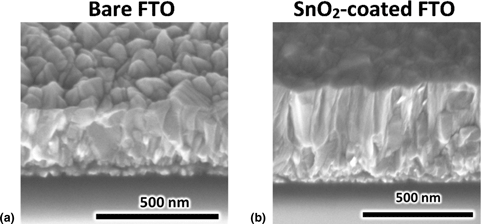Crossref Citations
This article has been cited by the following publications. This list is generated based on data provided by
Crossref.
Ranjkesh, Alireza
Gharesi, Mohsen
and
Hossein-Babaei, Faramarz
2019.
SnO2:F Films Grown by Ultrasonic Spray Pyrolysis Suitable for Transparent Defogger Fabrication.
p.
398.
Laschuk, Nadia O.
Obua, Adaobi
Ebralidze, Iraklii I.
Fruehwald, Holly M.
Poisson, Jade
Egan, Jacquelyn G.
Gaspari, Franco
Naumkin, Fedor Y.
Easton, E. Bradley
and
Zenkina, Olena V.
2019.
Spacer Conjugation and Surface Support Effects in Monolayer Electrochromic Materials.
ACS Applied Electronic Materials,
Vol. 1,
Issue. 8,
p.
1705.
Verma, Anand
Martineau, David
Hack, Erwin
Makha, Mohammed
Turner, Erik
Nüesch, Frank
and
Heier, Jakob
2020.
Towards industrialization of perovskite solar cells using slot die coating.
Journal of Materials Chemistry C,
Vol. 8,
Issue. 18,
p.
6124.
Thomas, R.
Mathavan, T.
Shkir, Mohd.
AlFaify, S.
Kim, Hyun-Seok
and
Kathalingam, A.
2020.
Influence of yttrium doping on microstructural and optical properties of FTO thin films prepared by nebulizer spray technique.
Materials Today Communications,
Vol. 24,
Issue. ,
p.
101087.
Thomas, R.
Mathavan, T.
Jothirajan, M.A.
Ganesh, V.
Shkir, Mohd
Yahia, I.S.
Zahran, H.Y.
and
AlFaify, S.
2020.
Tailoring the properties of nebulizer spray pyrolysis coated FTO thin films through rare earth element terbium for optoelectronic applications.
Physica B: Condensed Matter,
Vol. 580,
Issue. ,
p.
411916.
Wang, Kunqiang
Ke, Xi
Wang, Weizhe
Tu, Chen
Luo, Dongxiang
and
Zhang, Menglong
2020.
The Impacts of Fluorine-Doped Tin Oxide Photonic Crystals on a Cadmium Sulfide-Based Photoelectrode for Improved Solar Energy Conversion under Lower Incidence.
Catalysts,
Vol. 10,
Issue. 11,
p.
1252.
Thomas, R.
Mathavan, T.
Jothirajan, M.A.
Somaily, H.H.
Zahran, H.Y.
and
Yahia, I.S.
2020.
An effect of lanthanum doping on physical characteristics of FTO thin films coated by nebulizer spray pyrolysis technique.
Optical Materials,
Vol. 99,
Issue. ,
p.
109518.
Peng, Guoliang
Lu, Huidan
Liu, Yongping
and
Fan, Dayong
2021.
The construction of a single-crystalline SbSI nanorod array–WO3 heterostructure photoanode for high PEC performance.
Chemical Communications,
Vol. 57,
Issue. 3,
p.
335.
KOÇ, Murat
2021.
Ultrasonik Sprey Piroliz ile Üretilen ZnO İnce Filmlerin Alttaş Sıcaklıklarının Yapısal ve Optik Özelliklerine Etkisi.
Süleyman Demirel Üniversitesi Fen Edebiyat Fakültesi Fen Dergisi,
Vol. 16,
Issue. 1,
p.
169.
Bandara, T. M. W. J.
Aththanayake, A. A. A. P.
Kumara, G. R. A.
Samarasekara, P.
DeSilva, L. Ajith
and
Tennakone, K.
2021.
Transparent and conductive F-Doped SnO2 nanostructured thin films by sequential nebulizer spray pyrolysis.
MRS Advances,
Vol. 6,
Issue. 16,
p.
417.
Xiao, X.J.
Tu, J.L.
Liu, Z.M.
and
Liu, L.
2022.
First principles study of the electronic and optical properties of high‐valence transition metal‐doped anatase titanium dioxide.
Materialwissenschaft und Werkstofftechnik,
Vol. 53,
Issue. 12,
p.
1551.
Qiu, Qingqing
Bai, Yu
Li, Junjun
Guo, Cong
Chen, Hongyuan
Zhang, Haichuan
Shi, Jianhua
Liu, Wenzhu
Chen, Tao
Liao, Jiaxuan
and
Yu, Jian
2023.
ZnO‐Doped In2O3 Front Transparent Contact Enables >24.0% Silicon Heterojunction Solar Cells.
Energy Technology,
Vol. 11,
Issue. 4,
Uwihoreye, Vedaste
Yang, Zhenni
Zhang, Jia-Ye
Lin, Yu-Mei
Liang, Xuan
Yang, Lu
and
Zhang, Kelvin H. L.
2023.
Transparent conductive SnO2 thin films via resonant Ta doping.
Science China Materials,
Vol. 66,
Issue. 1,
p.
264.
Li, Mengqing
Cao, Wenhuan
Min, Xiangfei
Li, Wenhui
Wang, Xueze
Gao, Huidan
Zhou, Huawei
Yin, Jie
and
Zhang, Xianxi
2023.
An efficient low-cost and facile ITO interdigital micro-photodetector based on mixed cationic perovskites for screening new optoelectronic materials.
New Journal of Chemistry,
Vol. 47,
Issue. 32,
p.
15010.
Shaver, Alexander
and
Arroyo-Currás, Netzahualcóyotl
2023.
Expanding the Monolayer Scope for Nucleic Acid-Based Electrochemical Sensors Beyond Thiols on Gold: Alkylphosphonic Acids on ITO.
ECS Sensors Plus,
Vol. 2,
Issue. 1,
p.
010601.






